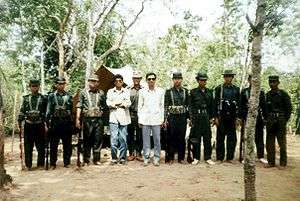Shanti Bahini
| Shanti Bahini | |
|---|---|
|
শান্তি বাহিনী Participant in the Chittagong Hill Tracts conflict | |
 Flag of the Shanti Bahini | |
| Active | 1972–1997 |
| Ideology | Autonomy for the indigenous tribes of the Chittagong Hill Tracts |
| Leaders |
M.N. Larma Shantu Larma |
| Area of operations | Chittagong Hill Tracts, Bangladesh |
| Size | 2,000–47,000[1] |
| Part of |
|
| Opponents | |
| Battles and wars | Chittagong Hill Tracts conflict |
The Shanti Bahini (Bengali: শান্তি বাহিনী; meaning "Peace Force") was the name of the armed wing of the Parbatya Chattagram Jana Samhati Samiti (United People's Party of the Chittagong Hill Tracts) in Bangladesh. It is considerend an insurgent group in Bangladesh.[2] The Shanti Bahini was made out of mostly members from the Chakma tribe.[3]
History
Following the independence of Bangladesh in 1971, Manabendra Narayan Larma founded the Parbatya Chattagram Jana Samhati Samiti (PCJSS) on February 15, 1972, seeking to build an organization representing all the tribal peoples of the Chittagong Hill Tracts. Larma was elected to the Bangladesh Jatiya Sangsad, the national legislature of Bangladesh as a candidate of the PCJSS in 1973.[4] When Larma's continued efforts to make the government recognize the rights of the tribal peoples through political discussions had failed,[5] Larma and the PCJSS began organizing the Shanti Bahini (Peace Corps), an armed force operating in the Hill Tracts area. It was formed in 1972 and fought for many years against the government.[6]

Shanti Bahini began attacking Bangladesh Army convoy in 1977.[7] They carried out kidnapping of civilians and extortion. Larma and his rebel force kept on fighting Bengali intrusion into tribal areas.[8][9][10] Being the main leader of the PCJSS and the Shanti Bahini, Larma consequently went into hiding from government security forces.[8][10] However, factionalism within the PCJS weakened Larma's standing and he was assassinated on November 10, 1983.[8][10] On 23 June 1981 the Shanti Bahini attacked a camp of Bangladesh rifles, killing 13 settlers. They captured and then killed 24 members of Bangladesh rifles.[11] In the 1980s the Government of Bangladesh started to provide land for thousands of landless Bengali settlers officially. Many settlers were forced to move to secure regions because of the insurgency, abandoning the land they were given and which was then taken over by tribal communities.[12] On 29 April 1986, Shanti Bahini attacked Bengali settlers and carried out a massacre.[13] In the attack 19 Bengali civilians were killed.[14] On 26 June 1989 the Shanti Bahini burned down villages where inhabitants had voted in Bangladeshi elections.[15] In 1996 Shanti Bahini abducted 30 Bengali settlers and killed them.[16] On 9 September 1996, Bengali woodcutters were called by the Shanti Bahini to a meeting. Where the woodcutters were killed and some of whom were decapitated.[17] Members of Shanti Bahini extorted the local population in the name of toll collection, the total amont of toll collected is estiamated to be 4 million dollar.[18]
It abandoned militancy following the signing of the Chittagong Hill Tracts Peace Accord between the government of Bangladesh led by Bangladesh Awami League and the PCJSS on 2 December 1997.[19] Members of Shanti Bahini surrendered their weapons in a stadium in Khagrachari. The treaty saw the lifting of nighttime curfew and the return of 50 thousand refugees.[20] However, some members opposed to the peace deal formed a dissident group.[21] Some of those who opposed the peace treaty formed the United People's Democratic Front as an alternate to the PCJSS.[22] The treaty was also criticised by the Bangladesh Nationalist Party.[23] The accord has not been completely implemented.[24] Some of the members of Shnati Bahini joined Bangladesh Police after the peace treaty. On November 2012, two of those members of Bangladesh police were arrested for stealing ammunition from the police.[25] On August 2014 Indian security forces arrested members of Shanti Bahini, two Bangladeshi and three Indian nationals, with weapons in Mizoram.[26]
Foreign help
After the assassination of Sheikh Mujibur Rahman and the removal of Bangladesh Awami League from in 1975,[27] India provided support and shelter to the members of Shanti Bahini.[28][29][30] Members of Shanti Bahini were trained in Chakrata, India.[31][32] The Chief Minister of West Bengal, Jyoti Basu, had asked Indian intelligence agency, RAW, not to support the Shanti Bahini.[33] The election victory of Bangladesh Awami League in 1996, it appeared foreign support would be reduced and in 1997 a peace treaty was signed between the government and members of Shant Bahini.[24]
See also
References
- ↑ Does Peacekeeping Work?. Retrieved 8 March 2015.
- ↑ "Where is Kalpana?". The Daily Star. 2016-06-12. Retrieved 2017-04-16.
- ↑ Ahmed, Ishtiaq (1998-01-01). State, Nation and Ethnicity in Contemporary South Asia. A&C Black. p. 235. ISBN 9781855675780.
- ↑ Kader, Rozina (2012). "Larma, Manabendra Narayan". In Islam, Sirajul; Jamal, Ahmed A. Banglapedia: National Encyclopedia of Bangladesh (Second ed.). Asiatic Society of Bangladesh.
- ↑ "An engrossing perspective on the Chittagong Hill Tracts". The Daily Star. 2017-02-06. Retrieved 2017-04-16.
- ↑ Hazarika, Sanjoy (11 June 1989). "Bangladeshi Insurgents Say India Is Supporting Them". The New York Times.
- ↑ "18 DAYS THAT SHOOK BANGLADESH". The Daily Star. 2014-06-06. Retrieved 2017-04-16.
- 1 2 3 Nagendra K. Singh (2003). Encyclopaedia of Bangladesh. Anmol Publications Pvt. Ltd. p. 229. ISBN 81-261-1390-1.
- ↑ Bushra Hasina Chowdhury (2002). Building Lasting Peace: Issues of the Implementation of the Chittagong Hill Tracts Accord. University of Illinois at Urbana Champaign Pr. Archived from the original on 2006-09-01.
- 1 2 3 Kader, Rozina (2012). "Shanti Bahini". In Islam, Sirajul; Jamal, Ahmed A. Banglapedia: National Encyclopedia of Bangladesh (Second ed.). Asiatic Society of Bangladesh.
- ↑ The Election Archives. Shiv Lal. 1982-01-01. p. 218.
- ↑ "Chittagong Hill Tracts land issue". The Daily Star. 2013-09-25. Retrieved 2017-04-16.
- ↑ "Samo Adhiker demands punishment of culprits". The Daily Star. 2008-04-30. Retrieved 2017-04-16.
- ↑ Uddin, G. M. Masbah (1992-01-01). The Chittagong Hill Tracts: falconry in the hills. s.n. p. 82.
- ↑ Tahir, Naveed Ahmad (1997-01-01). The Politics of Ethnicity and Nationalism in Europe and South Asia. Area Study Centre for Europe, University of Karachi. p. 145.
- ↑ "Militant attacks in Bangladesh claim 393 lives in last 11 years | Dhaka Tribune". archive.dhakatribune.com. Retrieved 2017-04-16.
- ↑ "Army pullout from CHT opposed by settlers". archive.thedailystar.net. The Daily Star. Retrieved 2017-04-16.
- ↑ Asian Survey. University of California Press. 1981-01-01. p. 190.
- ↑ "CHT accord and ten wasted years". The Daily Star. 2007-12-06. Retrieved 2017-04-16.
- ↑ "Peace Accord must not remain on paper only". The Daily Star. 2013-12-02. Retrieved 2017-04-16.
- ↑ "One rescued as BD commandoes search for kidnapped workers". Daily Times. Archived from the original on 30 July 2012.
- ↑ "Brother against brother". The Daily Star. 2010-01-21. Retrieved 2017-04-16.
- ↑ Chima, Jugdep S. (2015-03-24). Ethnic Subnationalist Insurgencies in South Asia: Identities, Interests and Challenges to State Authority. Routledge. ISBN 9781317557050.
- 1 2 "A saga of un-kept promises". The Daily Star. 2016-12-02. Retrieved 2017-04-16.
- ↑ "Police start counting ammo at all units". The Daily Star. 2012-11-02. Retrieved 2017-04-16.
- ↑ "Two Bangladeshi Chakmas among five arrested with huge arms in India". bdnews24.com. Retrieved 2017-04-16.
- ↑ Prakash, Ved (2008-01-01). Terrorism in India's North-east: A Gathering Storm. Gyan Publishing House. p. 553. ISBN 9788178356617.
- ↑ Times, Sanjoy Hazarika, Special To The New York (1989-06-11). "Bangladeshi Insurgents Say India Is Supporting Them". The New York Times. ISSN 0362-4331. Retrieved 2017-04-16.
- ↑ "Bangladesh is in 'Great Game'". The Daily Star. 2014-02-12. Retrieved 2017-04-16.
- ↑ "The India-Bangladesh Relationships - Lookback and Reality Check". TIMES OF ASSAM. 2014-05-09. Retrieved 2017-04-16.
- ↑ Gunaratna, Rohan; Iqbal, Khuram (2012-01-01). Pakistan: Terrorism Ground Zero. Reaktion Books. p. 219. ISBN 9781780230092.
- ↑ Hazarika, Sanjoy (2000-10-14). Strangers Of The Mist: Tales of War and Peace from India's Northeast. Penguin UK. ISBN 8184753349.
- ↑ "Behind the "RAW" tirade". The Daily Star. 2017-03-18. Retrieved 2017-04-16.